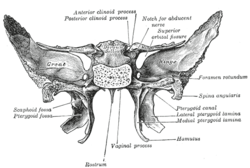Anterior clinoid process
| Anterior clinoid process | |
|---|---|
 Upper and posterior surfaces of sphenoid bone (anterior clinoid process visible at top left) | |
|
Upper surface of the base of the skull (label for anterior clinoid process visible at center left. Sphenoid bone is yellow.) | |
| Details | |
| Identifiers | |
| Latin | Processus clinoideus anterior |
| TA | A02.1.05.022 |
| FMA | 54693 |
In the sphenoid bone, the posterior border, smooth and rounded, is received into the lateral fissure of the brain; the medial end of this border forms the anterior clinoid process, which gives attachment to the tentorium cerebelli;[1] it is sometimes joined to the middle clinoid process by a spicule of bone, and when this occurs the termination of the groove for the internal carotid artery is converted into a foramen (carotico-clinoid).
Etymology
The anterior and posterior clinoid processes surround the sella turcica like the four corners of a four poster bed. Cline is Greek for bed. –oid, as usual, indicates a similarity to.[1] The term may also come from the Greek root klinein or the Latin clinare, both meaning "sloped" as in "inclined."
Additional images
-

Anterior clinoid process]]
References
This article incorporates text in the public domain from the 20th edition of Gray's Anatomy (1918)
- 1 2 "Anterior clinoid process of the sphenoid bone". AnatomyExpert. Retrieved 20 March 2013.
External links
- Anatomy diagram: 34257.000-2 at Roche Lexicon - illustrated navigator, Elsevier
- Anatomy photo:22:os-0910 at the SUNY Downstate Medical Center